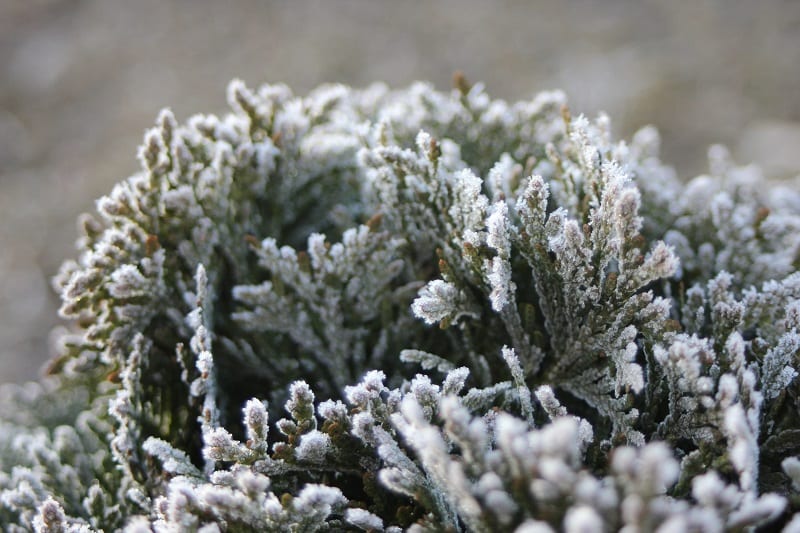
(Photo: 0x010C/Wikimedia Commons)
While a snowy winter can be good for your garden, cold weather, particularly frost, causes the water in plant cells to freeze, damaging the cell wall.
Frost-damaged plants are easy to spot. Their growth becomes limp, blackened, and distorted. Evergreen plants turn brown and the leaves of tender plants take on an almost luminous appearance.
Problems brought on by frost are often made worse in places where plants face the morning sun. The sunlight causes plants to defrost quickly, rupturing their cell walls.
Minimizing the damage of frost
Contents
Hardy plants and tough evergreens can also be damaged by prolonged periods of severe cold. When the soil freezes, roots are unable to absorb water. Eventually, the plants die from lack of moisture. Frosty weather can also kill blossoms and damage fruit.
But frost damage does not necessarily mean the end for your plants. Many plants will recover given time.
There are also ways to minimize damage.

Protect plants from the morning sun in winter
Protect damaged plants from the morning sun, which can impair growth if plants defrost too quickly. If you can’t move the plants, try covering them with a sheet of black plastic to block out the sun.

Cut frosted growth in the spring
Cut back frosted growth in spring to a healthy, new bud. This will allow you to prevent further dieback and encourage plants to produce fresh, new shoots.

Use a balanced fertilizer on damaged plants
Use a balanced fertilizer when caring for frost-damaged plants. Your best is a mixture with equal amounts of Nitrogen, Phosphorus and Potassium.
A balanced fertilizer will help damaged plants recover and encourage
strong, healthy growth.

Shelter damaged tender plants in the greenhouse
Dig up small, tender plants and take them into the greenhouse. Many will quickly produce new growth and recover, provided they are not subjected to prolonged periods of heavy frost, wet, or cold.

(Photo: Glen Bowman/Flickr)
Check on young plants regularly
If you do not have a greenhouse, check on your young plants regularly. Young plants will often lift themselves from the soil surface if there is a hard frost after planting.
Make sure the ground around them is compressed to ensure their roots are always in contact with the soil.

Dealing with snow in your garden
Snow acts as an insulator, protecting plants from the cold and frost. However, a heavy layer of snow can cause leaves and branches to break.
Gently shake or brush excess snow from the branches of large trees, shrubs, and hedges, to prevent them from becoming disfigured by the weight.
You should also avoid walking on snow-covered grass. You might damage the turf beneath and leave unsightly marks on your lawn.
So just how much cold will kill a plant? Not much, most experts agree, although this is usually dependent on the hardiness of the plant.
Typically, temperatures falling below freezing will quickly injure or even kill many types of plants. But with prompt and intelligent care, many cold-damaged plants can be rescued.








